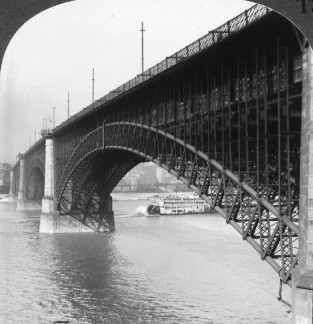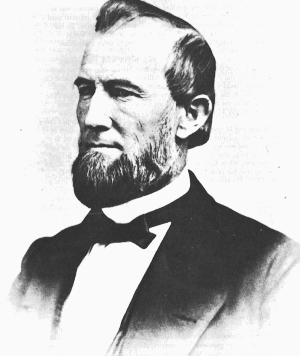Under Pressure
Today, the story of a great bridge and a mysterious disease. The University of Houston's College of Engineering presents this series about the machines that make our civilization run, and the people whose ingenuity created them.
James Eads, born in Indiana in 1820, was uneducated but smart and well-read. In his 20s he designed a diving bell and worked at salvaging cargo from sunken river boats. During the Civil War, Eads built ironclad gunboats. He was at home in our inland river system.
At the age of 46, Eads, who'd never built a bridge, was called on to bridge the Mississippi at St. Louis. Here he flew in the face of conventional wisdom. Instead of the usual truss bridge, he proposed to build three huge cantilever arches, 500 feet long.
The real trick would be placing the piers right in the middle of the largest river in the world. Eads knew the swirling mess of moving mud and silt that made up the river bottom. And he knew bedrock lay 100 feet deeper still. But how to solve the problem? The answer turned up in France, where he found a technology for setting piers in soil under water -- the plenum pneumatic, or caisson. He'd use caissons, but on a scale they'd never been used.
He built an 80x60-foot steel box, nine feet high and open at the bottom like a great cookie cutter. At first it floated on air trapped inside. Then, as Eads built the masonry pier on top of it, it sank down to the riverbed. He pumped pressurized air into the caisson to keep the water and mud out.
Workers descended a stairwell through the masonry to the caisson and entered it through an airlock. Inside, they dug out mud while the whole structure gradually settled downward toward bedrock. Workers above kept piling the masonry pier on top of it.
Things went fine for a while. When the pressure in the caisson reached twice atmospheric pressure, workers felt pains in their joints as they left the caisson. Since they had trouble standing straight, they called the problem "the bends." When they reached a depth where the pressure was three atmospheres, Eads had to send men to the hospital. Some suffered total paralysis. They began dying.
All the while, Eads took visitors into the caissons. They found it exciting when they couldn't whistle in the dense air. But none suffered any problems. Obviously, the less time you spent below, the less you suffered. Eads gradually reduced the work cycle to only 45 minutes. Doctors were baffled.
Historian David Diaz tells how autopsies revealed swollen blood vessels and dark, tarry blood, but no explanation. Fourteen deaths later, the bridge finally opened. It was a remarkable accomplishment. Even today, those piers are the deepest on record.
Meanwhile, the contractors went bankrupt. A few years later, we saw that, if you breathe high pressure air very long, your blood absorbs its nitrogen. Then, when you quickly depressurize, nitrogen bubbles come out of solution and raise havoc with your body.
So Eads gave us a great 19th-century engineering triumph. But he also left us painfully aware -- of the terrible price of learning.
I'm John Lienhard, at the University of Houston, where we're interested in the way inventive minds work.
(Theme music)
Diaz, D., Under Pressure. American Heritage of Invention and Technology, Spring, 1996, pp. 52-63.

The Eads Bridge at St. Louis
From the 1897 Encyclopaedia Britannica

Early 20th century photo of the Eads Bridge
Stereopticon image courtesy of Margaret Culbertson

James B. Eads, designer of both the St. Louis/Illinois
Bridge and the U.S.S. Cairo (Episode 280)
U.S.S. Cairo, U.S. National Park Service, 1985